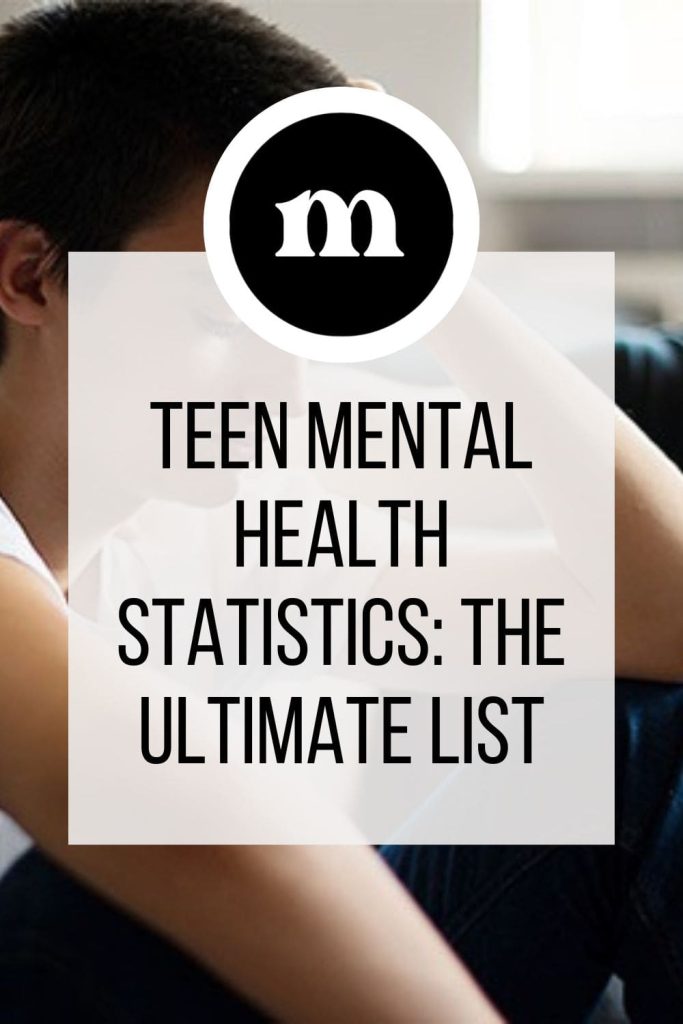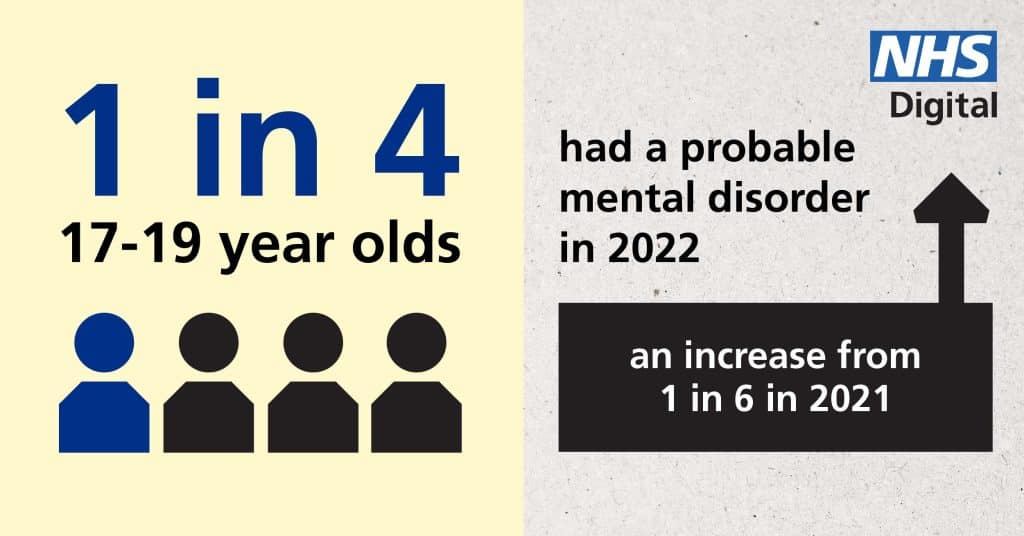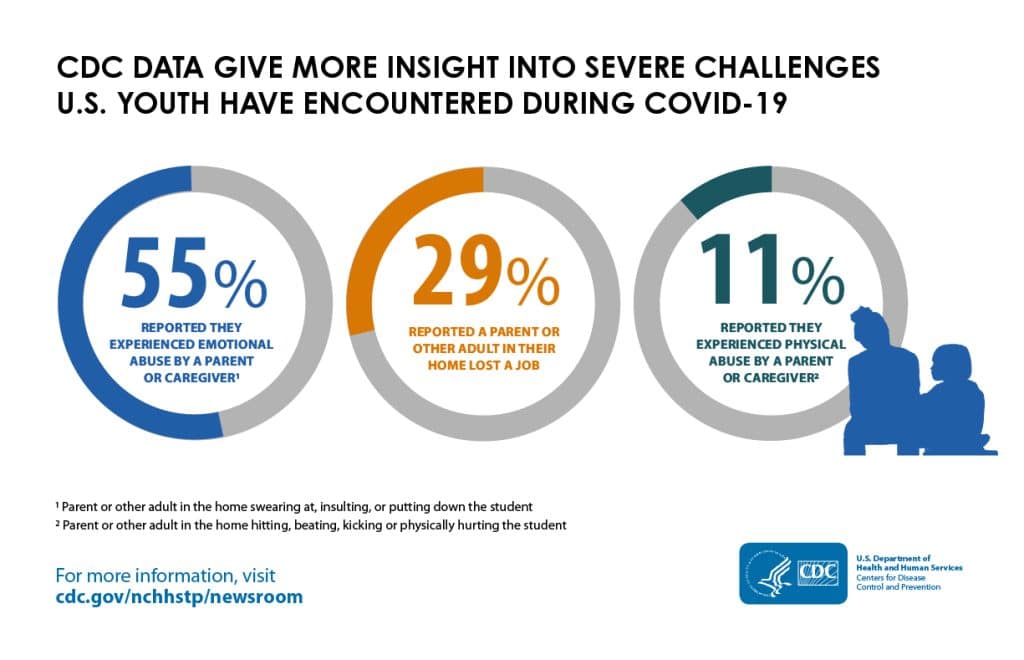Mental health is a significant concern among teenagers today, with many facing unique challenges in an increasingly complex world.
Understanding the prevalence and impact of mental health issues is crucial in supporting the well-being of young individuals.
By delving into these numbers, we hope to raise awareness, drive conversations, and inspire action to support and improve the well-being of teenagers worldwide.
50 Teen mental health statistics

1. Prevalence of Mental Health Disorders
- In the US, 1 in 5 young people aged 9-17 have a mental health disorder according to the American College of Obstetricians and Gynecologists, 2020.
- 50% of all lifetime mental illness begins by age 14, and 75% by age 24 according to the American Psychiatric Association
- Mental health disorders (depression, anxiety, and behavioral disorders) are the leading cause of disability among teenagers. (WHO, 2021)
- ADHD affects 9.8% of teens according to CDC, 2022.
- Globally, one in seven 10-19-year-olds experiences a mental disorder, accounting for 13% of the global burden of disease in this age group. (WHO, 2021)
- Exposure to violence, including gun violence, is associated with an increased risk of mental health issues in teens. (Springer, 2023)
- 70% of juvenile justice-involved youth have a mental health disorder. (NCBI, 2016)
2. Depression and Anxiety
- Depression in adolescents is a major risk factor for suicide, the second-to-third leading cause of death in this age group. (NCBI, 2012)
- Anxiety disorders affect 31.9% of teens and adolescents aged 13 and 18 years according to the Anxiety & Depression Association of America.
- Social media use is associated with an increased risk of depression and anxiety in teens. (MayoClinic, 2022)
- Native American teens have the highest rate of suicide of any racial or ethnic group in the US. (JAMANetwork, 2021)
- Bullying is a risk factor for depression and anxiety in teens. (BioMedCentral, 2023)
3. Suicide Rates

- Suicide is the second leading cause of death among individuals aged 15-24. (ACOG, 2020)
- LGBTQ+ teenagers are 3 times more likely to attempt suicide than their heterosexual peers. (Journal of Homosexuality, 2010).
- Teen girls are more likely to attempt suicide than teen boys, but teen boys are more likely to die by suicide. (International Journal of Public Health, 2019)
- Suicide risk is highest among teens who have a family history of suicide. (NCBI, 2021)
4. Self-Harm and Non-Suicidal Self-Injury
- Roughly 1 in 6 teenagers engage in self-harm or non-suicidal self-injury behaviors. (NCBI, 2008)
- Self-harm is more common in teen girls than teen boys. (Forbes, 2017)
5. Eating Disorders
- Anorexia nervosa is the third most common chronic illness among adolescents. (NCBI, 2019)
- Anorexia nervosa has the highest mortality rate of any psychiatric disorder. (BioMedCentral, 2020)
6. Substance Abuse
- About 1 in 7 teenagers have a substance use disorder according to American Addiction Centers, 2022
- NSDUH data suggest that only one in ten adolescents with alcohol or illicit drug disorder receive treatment. (NCBI, 2015)
- Marijuana is the most commonly used illicit drug among teenagers. (WHO)
- Substance abuse is a common co-occurring disorder with mental illness in teens. (National Institutes on Drug Abuse, 2020)
- Substance abuse can exacerbate underlying mental health issues in teens (National Institute of Mental Health)
7. Bullying and Cyberbullying
- Approximately 59% of teenagers report being victims of at least one of six types of abusive online behaviors. (PewResearchCenter, 2018)
- Online bullying, or cyberbullying, can have similar effects on mental health as traditional bullying. (NCBI, 2014)
8. Trauma and PTSD
- Trauma is a significant risk factor for mental health issues in teens. (NCBI, 2020)
- About 40% of teenagers have experienced a traumatic event according to Substance Abuse and Mental Health Services Administration, 2011
- Post-Traumatic Stress Disorder (PTSD) affects around 8% of teenagers who have experienced trauma. (NCBI, 2017)
9. Academic Pressure and Stress
- Nearly 30% of teenagers feel overwhelmed by academic stress. Chronic stress negatively affects learning, memory, and cognitive abilities. (VeryWellMind, 2023)
10. Sleep Disorders
- More than 70% of U.S. teenagers do not get enough sleep according to CDC
- Lack of sleep increases the risk of mental health disorders and impairs overall well-being. (NCBI, 2022)
11. Social Media Impact
- Excessive social media use is associated with higher rates of depression and anxiety in teenagers. (MayoClinic, 2022)
- Cyberbullying on social media platforms contributes to increased mental health challenges. (NCBI, 2014)
12. LGBTQ+ Mental Health
- LGBTQ+ teenagers face a higher risk of mental health issues, including depression, anxiety, and suicidal ideation according to CDC
- Family rejection significantly impacts the mental health of LGBTQ+ youth. (NCBI, 2016)
13. Peer Relationships
- Positive peer relationships promote mental health and resilience in teenagers. (NCBI, 2022)
14. Access to Mental Health Care
- Only 20% of teenagers with mental health disorders receive appropriate treatment according to CDC
- Limited access to mental health services contributes to the treatment gap. (NCBI, 2020)
15. Stigma and Barriers to Help-Seeking
- The stigma surrounding mental health prevents many teenagers from seeking help according to American Psychiatric Association
- Hispanic and Latino teens are also less likely to receive mental health treatment compared to their white peers. (NCBI, 2020)
16. School-based Mental Health
- Support Schools with mental health programs have higher academic performance and reduced behavioral issues. (NCBI, 2014)
- Integrating mental health education in schools helps reduce stigma and increase help-seeking behavior. (NCBI, 2014)
17. Parental Support and Communication
- Strong family relationships and open communication protect against mental health challenges. (JAMANetwork, 2019)
- Parental involvement positively impacts the mental well-being of teenagers. (JAMANetwork, 2019)
18. Economic Disparities ‘
- Teenagers from low-income households face barriers to accessing mental health services. (NCBI, 2017)
- Socioeconomic factors contribute to mental health disparities among teenagers. (NCBI, 2019)
- Homelessness is a risk factor for mental illness in teens. (NCBI, 2020)
19. Gender Differences
- Teen girls are three times more likely to experience depression than teen boys. (PewResearchCenter, 2019)
- Boys are more prone to externalizing behaviors such as aggression and substance abuse. (NCBI, 2004)
20. Cultural and Ethnic Factors
- Cultural and ethnic backgrounds influence the expression and perception of mental health disorders. (Frontiersin, 2018)
How does mental health affect teens? Unraveling the Connection

The influence of mental health on teenagers is profound and far-reaching. Understanding how mental health affects teens is crucial for addressing their well-being and providing appropriate support.
1. Emotional Well-being
Mental health significantly impacts the emotional well-being of teens, shaping their overall mood, happiness, and ability to cope with stress.
2. Academic Performance
Poor mental health can hinder teens’ concentration, focus, and motivation, leading to academic challenges and underachievement.
3. Social Relationships
Mental health issues can strain relationships with family, friends, and peers. Teens may experience difficulties in forming and maintaining meaningful connections.
4. Physical Health
Mental health problems often manifest physically, contributing to issues like headaches, fatigue, stomachaches, and sleep disturbances in teenagers.
5. Risky Behaviors
Teens with compromised mental health may be more prone to engaging in risky behaviors such as substance abuse, self-harm, or unprotected sexual activity.
6. Self-esteem and Body Image
Mental health influences self-esteem and body image perception, leading to negative self-worth, body dissatisfaction, and even eating disorders.
7. Psychological Disorders
Mental health problems in teens can lead to the development of various psychological disorders such as depression, anxiety, bipolar disorder, or eating disorders.
8. Educational Attainment
Persistent mental health challenges may disrupt teens’ educational trajectories, impacting their ability to complete school or pursue higher education.
9. Peer Pressure
Vulnerabilities in mental health can make teens more susceptible to negative peer influences, potentially leading to harmful behaviors or involvement in risky situations.
10. Long-term Impact
Untreated mental health issues during adolescence can have long-term consequences, including a higher risk of mental health problems in adulthood.
11. Resilience and Coping Skills
Promoting positive mental health equips teens with resilience and effective coping strategies to navigate challenges and adversity throughout their lives.
12. Mental Health Stigma
Negative attitudes and stigma surrounding mental health can exacerbate the difficulties faced by teenagers, preventing them from seeking help and support.
13. Impact on Family
Mental health issues affect the entire family, creating emotional strain, disruptions in daily routines, and increased caregiving responsibilities.
14. School Performance
Teens’ mental health can impact their engagement, attendance, and performance in school, potentially affecting their future opportunities and career prospects.
15. Access to Resources
The availability and accessibility of mental health resources and support systems greatly influence the well-being of teens, shaping their ability to seek help when needed.
What Next?
These 50 statistics on teenage mental health paint a comprehensive picture of the challenges teenagers face in terms of mental health.
By acknowledging the prevalence and impact of these issues, we can work together to create supportive environments, advocate for accessible mental health services, and foster open conversations about well-being.
Let us prioritize the mental health of our teenagers and empower them to lead fulfilling and resilient lives.
